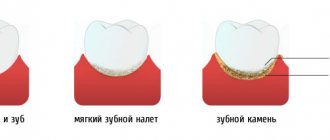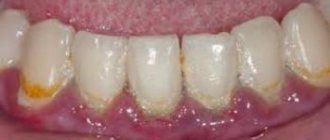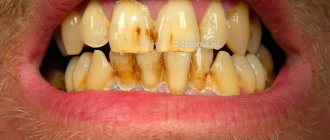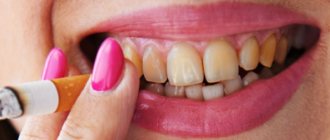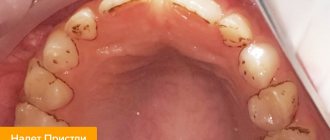Black plaque on teeth, or Priestley's plaque, occurs for various reasons. It may indicate caries, gastrointestinal problems, enamel diseases, or simply poor oral hygiene. It often appears in children aged 2-3 years. In this article we will tell you what to do if your child’s teeth become black.
In this article
- Black plaque on children's teeth: causes of formation
- A child has black teeth - what to do?
- Black teeth in children: possible complications
- Other types of plaque depending on color
- Prevention of dental plaque in children
Black plaque on teeth can appear suddenly at any age, but, according to statistics, it is 8-10 times more common in children. It looks like an uneven border of a dark color, almost black, running along all the teeth closer to the gums. In rare cases, it appears as a small spot or blackhead, often forming on the inside of the teeth.
This symptom is also called Priestley's plaque in honor of the scientist who first described it. He also named the possible reasons for its formation. The danger to health is not so much the plaque itself, which is not a pathology, but a symptom, but rather the disease that provoked its appearance.
What is Priestley's plaque?
Priestley's plaque is dark stains on children's baby teeth, which are a consequence of the activity of certain types of bacteria.
The appearance of a dark, almost black plaque on a child’s teeth can be observed at any age - both at one year old and at an older age. This is a very common occurrence on baby teeth.
As a result, due to black teeth in children, the smile becomes unattractive, and bad breath often appears.
Priestley's plaque on a child photo
However, it is not the child’s black teeth that should alert parents, but the fact that the appearance of this symptom is a signal that some kind of malfunction has occurred in the baby’s body. And to eliminate it, the first thing you need to do is consult a doctor - a pediatric dentist.
How to prevent blackening of teeth
Blackening of teeth can be prevented by teaching your child to regularly take care of the oral cavity and not to eat late in the evening. It is worth cleaning baby teeth with plain water or chamomile decoction, after which you can switch to children’s toothpastes. If your child still experiences darkening of the teeth, you should contact your dentist. As a rule, doctors first clean the top layer of dental tissue and then cover it with special cement. In some cases, the silver plating method is used. If caries is already in the active stage of development, it is best to remove the tooth so that the disease does not spread to neighboring ones. Take care of your child's teeth, and then there will be no problems with them.
Article material approved by doctor: Evgeniy Aleksandrovich Nikitin Dentist-therapist, orthopedist, pediatric dentist
10 years
Causes of black plaque on children's teeth
There are many factors that cause black plaque on baby teeth. It is almost impossible to independently identify the cause, so you need to consult a doctor.
The most common causes of its occurrence are the following:
- Priestley's plaque in a child is the most common cause. This is due to special bacteria that produce a black pigment. It settles on the enamel, but goes away completely with age and almost never transfers to permanent teeth. This phenomenon is not dangerous to health and is considered only an aesthetic problem. Plaque can be removed at the dentist, but after a while it will still return. So you just need to wait until it goes away on its own.
- Caries. An equally common, but much more serious reason, since baby teeth are susceptible to the development of disease. They first turn yellow, black spots and spots appear, after which they turn black. The danger is that the disease will spread to permanent teeth if treatment is not started immediately.
- Dysbacteriosis. This disease can also cause problems with the digestive tract. Often occurs due to poor nutrition of the child, long-term use of antibiotics, and the presence of chronic liver or intestinal diseases.
- Excess iron. Quite often, young children are prescribed iron supplements, which often leads to the appearance of dark deposits on the teeth. At the same time, the color of the plaque can change from black to dark purple or brown.
In addition to the reasons listed, plaque can appear due to a lack of calcium, which certainly affects the teeth first. Sometimes it occurs due to impaired intestinal microflora or as a result of poor heredity - if the child’s parents had the same problem in childhood. In any case, to find out exactly the cause, it is necessary to consult a doctor in a timely manner for examination.
Possible consequences after a bruise
It is no secret that any injury received can subsequently cause complications. A tooth bruise is no exception. Moreover, the consequences can appear even when appropriate treatment has been performed. This occurs if the pulp zone has been severely damaged.
The tissue will gradually begin to die and necrosis will appear. With necrosis, inflammation occurs, which must be addressed immediately. The earlier it is identified, the more successful the forecasts will be.
But the most common occurrence is staining. Parents notice that the child’s tooth has darkened after being hit. Darkening occurs quite quickly. This may be due to periodontal trauma, or may be a consequence of a lack of nutrients. They cannot supply what is needed because the dental tissues and fibers are damaged.
There are also more serious violations that occur over time. These include the formation of cysts in damaged areas.
In any of the above cases, adequate treatment often brings positive results.
Diagnosis and treatment methods of Priestley plaque
The appearance of black plaque can be the result of various diseases. In order to prevent them from starting and to prevent the development of complications, it is necessary to carry out a number of diagnostic measures. Even if a small spot appears on a tooth, you should visit a doctor and undergo laser diagnostics.
If it is caries, then at an early stage of development it is much easier to cure. In addition, the doctor may prescribe additional tests: blood and urine tests. Depending on the results obtained, appropriate treatment methods are selected:
- If problems with the gastrointestinal tract are identified, it is necessary to review the child’s nutritional system. In this case, a special diet is prescribed and some foods are excluded from the diet.
- Lack of calcium or excess iron can be easily treated by taking corrective medications and eating certain foods in greater or lesser quantities.
- When identifying caries at an early stage , dental procedures such as silver plating or fluoridation can help. The doctor treats the teeth with a special solution, which helps prevent further development of the disease and wait for healthy permanent teeth.
- Common Priestley plaque can be removed by professional cleaning by a doctor. But, unfortunately, this is not a guarantee that it will not appear again after a while.
If stains or plaque on the teeth cause pain or discomfort to the child, fillings are used to preserve the teeth and eliminate discomfort.
Irreversible change in enamel color
It also happens that after erupting a tooth immediately stands out in an unusual color - from purple or green to different shades of brown. Parents cannot even imagine why their child’s tooth has darkened. The main reasons for this condition may be the following:
- Taking tetracycline drugs by the mother during pregnancy or treating the baby with tetracycline without the knowledge of the doctor.
- Hemolytic disease of newborns without adequate correction.
- Fluorosis. In this case, the teeth become mottled with dark spots on the glossy white enamel. The disease develops when drinking water with a high concentration of fluoride is consumed during the formation of dental tissues. It's not dangerous, but not aesthetically pleasing.
Teeth with such types of pathology remain multi-colored until the bite changes.
Why do you need to remove Priestley plaque?
Not all children develop dark plaque on their teeth. This is due to the fact that the body reacts differently to changes in diet, environment and other factors.
In some cases, the spots may develop gradually, and in others they form abruptly, in just a few days. At the same time, age is not important: spots can appear already in the first months after teething, although on average they form at 2 years.
There are several reasons for removing Priestley plaque in children:
- Firstly, this is an aesthetic defect that attracts unnecessary attention to the baby’s mouth.
- Secondly, bad breath due to bacterial growth.
- Thirdly, under the guise of spots, the beginnings of carious lesions of the enamel may be hidden.
You can get professional services from a dentist and advice on this issue in Moscow at the Aesculapius dental clinic. Our specialists constantly encounter similar formations in children and know very well how to deal with it.
In just one session we will restore healthy enamel color using completely safe methods. At the same time, services for removing black plaque on a child’s teeth are available inexpensively in our clinic. We cooperate with each client on individual terms and adapt to the patient’s needs.
Also, if necessary, our doctors are ready to perform qualified treatment of childhood caries and other dental procedures. Our medical complex provides a wide range of services and can help with any oral ailment.
Does genetics have an effect?
Some researchers attribute individual susceptibility to dental caries to genetic factors. By studying the development of caries in animal models, Japanese scientists suggested that loci on chromosomes 1, 2, 7, 8 and 17 contribute to susceptibility to caries. Genetics does not directly influence the onset of the disease, but determines its severity and duration. This is explained by the peculiarities of the structure of the oral cavity: genes involved in the development of enamel, in the formation and composition of saliva, and also those involved in the formation of the immune response are closely studied [4], [8], [9].
How does the procedure for removing black plaque on teeth work?
Reliably and safely getting rid of dark spots on enamel is possible only with a professional dentist. Self-removal of black plaque in children using various folk remedies can lead to damage to the surface of the teeth.
Therefore, you should not self-medicate, but it is better to immediately use the services of specialists. At the Esculapius clinic we will find the root cause of the violation of the natural microflora of the mouth and eliminate the aesthetic defect from the enamel. At the same time, we use only effective methods that guarantee the highest quality results.
To treat Priestley's plaque, the Air Flow device is used, as well as ultrasound. During the procedure, a mixture of water, air and soda crystals is sprayed onto the teeth under pressure. The flow removes various types of deposits not only from the surface of the tooth, but also from the interdental spaces.
For children who do not really like brushing their teeth using the Air Flow method, soft plaque is removed with special brushes and pastes. After professional cleaning, the teeth are polished and become smooth, due to which less plaque settles on the enamel.
This procedure is available in our clinic at a reasonable cost. In addition, it is inexpensive to perform silvering of baby teeth - a preventive measure to strengthen the enamel and protect against caries, as well as other hygiene procedures. With us, your child's smile will be healthy and beautiful.
Caries
Children at an early age are characterized by the so-called “bottle caries”, which develops on several teeth at once due to the habit of falling asleep with a bottle of sweet nutritional mixture. Such food is to the taste not only of children, but also of microorganisms that rapidly multiply in the oral cavity in the presence of a carbohydrate substrate.
The hard dental tissues of toddlers are poorly mineralized, so when the surface layers of enamel are destroyed, they are quickly saturated with food coloring, acquiring a dark and sometimes even black color. Often, with a sufficient content of calcium salts in food, the carious process is stopped, the dentin becomes denser, but the dark color of the eroded surface remains.
With a lack of calcium, the carious process covers a significant area of the tooth surface, leading to its rapid destruction. If it is not possible to close large defects with a filling, then the dentist stops the destructive phenomenon using the silvering method - the enamel is treated with silver nitrate, which, when combined with protein molecules, forms an antimicrobial protective film. The disadvantage of this method is the blackening of the damaged areas, so the method is used on the front teeth only in young children.
Possible complications after plaque formation in children
It is strictly not recommended to ignore the problem and wait until it goes away on its own (unless diagnostics have been carried out and the absence of diseases has been revealed).
Black plaque on a child’s teeth can be not only an aesthetic problem, but also a symptom of more serious and health-threatening diseases, which in their advanced form will require expensive and difficult treatment.
In addition, they can cause complications, which will also lead to unpleasant consequences:
- Inflammation and bleeding of the gums when eating or brushing teeth.
- The risk of developing various dental diseases increases, in particular caries, stomatitis and periodontal disease.
- Dense dark plaque quite often turns into tartar, so even with safe Priestley plaque, professional teeth cleaning is recommended at least once every six months.
- The appearance of bad breath, accompanied by toothache and a feeling of discomfort.
If the progression of plaque is caused by the lack of treatment for caries, the disease begins to fill deeper cavities, which leads to the development of pulpitis, periodontitis and other related diseases. As a result, baby teeth may need to be removed, which is highly undesirable.
Symptoms of bruise
The symptoms of a severe bruise are obvious and easy to recognize. The area where the mechanical impact occurred causes unpleasant and painful sensations in the child. Children complain of severe pain when chewing food.
There are other common symptoms that can help diagnose a bruise:
- Hemorrhage is observed, due to which the enamel may turn pink. This occurs due to ruptures of blood vessels and tissues at the tooth base.
- A baby tooth darkened after a blow to a child, this is due to the fact that the periodontal tissue was injured. The periodontium is a complex of tissues that surround and hold human teeth in the alveolar area.
- There is slight loosening of the tooth. Although it is not too strong, it can be a symptom of damage to the alveolar bone. Untreated trauma to baby teeth can cause irreversible consequences that will negatively affect the formation of permanent teeth.
- There may be redness and swelling in the area where the main impact was made. The hematoma can be pronounced, or can only be detected by palpation. In any case, when you lightly press it, the child experiences pain and discomfort.
- A strong blow can lead to a more serious injury - a fracture of the alveolar process. If it is present, a person cannot make the usual movements of the jaw; when closing and opening the jaw, severe pain is observed.
- Ligament rupture resulting from a blow causes pain not only in the damaged area, but throughout the entire surface of the jaw. The child refuses to eat and becomes capricious.
In order to identify a bruise in a child, parents should closely monitor the health of their children. It is advised to pay due attention to every complaint that in one way or another may be related to the state of health.
Disease prevention
Preventive measures to prevent the development of dental diseases and the formation of plaque should be applied from the moment the baby first starts teething. The risk of unpleasant problems occurring can be significantly reduced by the following simple measures:
- Gentle oral care . Infants up to one year old can clean their gums with a cotton pad soaked in a decoction of chamomile, string, oak bark or sage. Special silicone attachments are also widely popular, which adults put on their fingers and thus clean the baby’s oral cavity. From the age of two, children must be taught to brush their teeth with a brush and toothpaste, and it is also advisable to rinse the mouth after each meal.
- Proper nutrition. This does not imply following any diets, but the child’s nutritional system should be designed in such a way as to limit his intake of sweets, sugar, confectionery and increase the consumption of healthy natural products. Sweets from the store are an excellent substitute for candied fruits, fruits and dried fruits.
- Timely abandonment of pacifiers and bottles. With prolonged use of a bottle or pacifier, an incorrect bite develops, dependence on accessories appears, and a black plaque forms, which in dentistry is called “bottle caries.” You should not delay in weaning your child off devices that he no longer needs.
- Maintaining the immune system. It is important to ensure that even in winter, the child has enough vitamins to maintain healthy teeth and the body as a whole.
By following these simple recommendations, you will ensure your child’s dental health and the beauty of a child’s smile.
